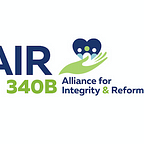The Evidence Is Clear: Policymakers Must Get 340B Back on Track
Over the past year, there has been a growing body of evidence that the 340B program doesn’t always best serve vulnerable or uninsured patient populations. Evidence has also raised questions about how some hospitals use the 340B program.
With 2019 approaching, we invite you to get caught up with key thought leaders, including government watchdogs, members of Congress, and patient advocates from across the nation who have concerns about whether vulnerable or uninsured patients benefit from 340B and the corrosive impact the program has had on the health care market.
“Accordingly, in assessing eligibility, the program favors hospitals that disproportionately serve low-income patients, but it does not require or provide incentives for hospitals to repurpose financial gains to enhance care for underserved patients. Rather, the discounts — which range from 20% to 50% — only strengthen the incentives for hospitals to supply drugs to patients who have generous insurance coverage. The extent to which hospitals support the mission of the program is subject to minimal oversight. Thus, the program may not elicit the intended responses from hospitals — such as providing more care to low-income communities, investing in safety-net providers, or reducing health disparities — and may even have unintended consequences.” — The New England Journal of Medicine, February 2018
“Here’s another uncomfortable fact: Nearly all of the billions in 340B discounts have accrued to hospitals. Yet hospitals’ charity care has dropped by almost $8 billion amid the 340B program’s astounding growth.” — Adam Fein, Drug Channels, May 2018
“We also found that many 340B hospitals with the highest operating margins provided the least amount of uncompensated care.” — Rena Conti, The Commonwealth Fund, March 2018
“Finally, while charity care spending often exceeds program savings, charity care levels have been on the decline at some hospitals, even as program savings increase.” — House Energy & Commerce Report, January 2018
As participation has sky-rocketed, bad actors have taken advantage of 340B. The potential profits generated by the steep discounts on 340B-eligible medicines incentivize hospitals to purchase independent physician practices such as oncology clinics and infusion centers. These sites, which provide vital treatments to patients, become targets for hospitals seeking to add more drug discounts to their bottom lines. As a result, we are seeing increasing consolidation in the health care market, forcing patients to commute farther away for more expensive treatment. This is particularly troubling in rural communities.
“Unfortunately, the lack of transparency, oversight, and accountability within the 340B program has led to unintended consequences including excessive growth of the program, expansion of its reach, closure of private oncology practices, and the shift to a much more expensive site of service in hospitals. When cancer care is shifted from private practices to the hospital outpatient department, the cost of care doubles.” — Dr. Debra Patt, U.S. Oncology, July 2018
“The 340B program may have also inadvertently raised costs — for example, by encouraging care in 340B-elegible hospitals that could have been provided less expensively elsewhere. A study in Health Services Research found that hospital participation in 340B is associated with a shift of cancer care from lower-cost physician offices to higher-cost hospital settings.” — Austin Frakt, The New York Times, August 2018
“I think it’s undeniable that 340B has actually led to consolidations, especially hospital acquisitions of independent physicians to be able to take advantage of the acquisition of drug cost or physician administered drugs to be at a lower cost and have that arbitrage.” — HHS Secretary Alex Azar, February 2018
“The 340B Program has been associated with hospital–physician consolidation in hematology–oncology and with more hospital-based administration of parenteral drugs in hematology–oncology and ophthalmology. Financial gains for hospitals have not been associated with clear evidence of expanded care or lower mortality among low-income patients.” — The New England Journal of Medicine, February 2018
While this continues, many thought leaders have raised overarching concerns about the integrity of 340B and whether it is sustainable in its current form.
“I don’t think there’s anyone here who doesn’t think this is a good program… but obviously it needs some safeguards. We need to change some things to make this program better.” — Rep. Buddy Carter, (R-GA-01), Energy and Commerce Committee hearing, July 2018
“We can, and should, provide accountability in a way that strengthens and preserves this program.” — Sen. Patty Murray (D-WA), March 2018
“It is important that Congress protect the integrity of 340B and ensure the program will continue to serve low-income Americans in need of care.” — Rep. Gene Green (D-TX-29), Energy and Commerce Committee hearing, July 2018
It is clear: There is growing evidence from a broad chorus of voices that the 340B program is not working as intended and more must be done to fix it. To learn more, visit: 340Breform.org
